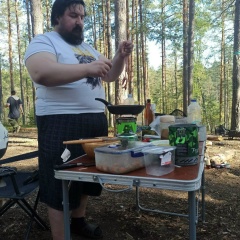===========О Корриде ==============
Периодически в среде прогрессивных испанцев всплывают дискуссии о запрете корриды, этого кровавого, жестокого и примитивного развлечения, отвечающего низменным потребностям толпы в зрелище. (Признаюсь, я на корриде не была и не собираюсь, но пару раз видела трансляции в барах - зрелище завораживает). Так вот теперь я попытаюсь изложить, что же именно меня заворожило.
Коррида для испанцев - отнюдь не праздное развлекалово. Это утративший свой сакральный смысл первобытный ритуал подчинения Зверя и Природы в его лице, от которого в прошлом зависело выживание племени. Но на бессознательном уровне коррида все еще носит священный характер. В прошлом подобный ритуал возможно являл собой часть магического обряда, когда символический поединок со Зверем гарантировал успешную охоту. Бык в данном случае выступал символом могущества Природы.
Отсюда глубокое уважение к самому процессу, тореро и быку. Коррида - не избиение и унижение быка на потеху толпе (как нередко пытаются представить защитники прав животных), а поединок равных, в котором погибнуть могут оба. На стороне быка - вся мощь и ярость природы, с которой человеку не тягаться, не будь он человеком. Поэтому единственный шанс тореро победить - обуздать свои животные инстинкты (в первую очередь, инстинкт самосохранения, который вопит о необходимости уносить ноги или хотя бы прикончить быка побыстрее), сохранить самоконтроль и, подчинив свои инстинкты, подчинить и быка.
Тореро выступает воплощением лучших качеств лидера: мужества, выдержки, самоконтроля, мастерства охотника, способного предугадывать действия быка, и убивать не под воздействием импульса, аффекта, а в строго выбранный момент и за определенное число ударов. (Вся процедура корриды подробно расписана в многотомных пособиях: в какой момент, через какое время, за какое число подходом и каким образом бык должен быть убит). Именно поэтому в случае ошибки тореро, в отличие от помощников, не может убежать с арены или спрятаться. Он противостоит Зверю до последнего и покидает арену "либо со щитом, либо на щите". За это народ платит ему уважением, сравнимым с почетом, оказываемым национальным героям.
Периодически в среде прогрессивных испанцев всплывают дискуссии о запрете корриды, этого кровавого, жестокого и примитивного развлечения, отвечающего низменным потребностям толпы в зрелище. (Признаюсь, я на корриде не была и не собираюсь, но пару раз видела трансляции в барах - зрелище завораживает). Так вот теперь я попытаюсь изложить, что же именно меня заворожило.
Коррида для испанцев - отнюдь не праздное развлекалово. Это утративший свой сакральный смысл первобытный ритуал подчинения Зверя и Природы в его лице, от которого в прошлом зависело выживание племени. Но на бессознательном уровне коррида все еще носит священный характер. В прошлом подобный ритуал возможно являл собой часть магического обряда, когда символический поединок со Зверем гарантировал успешную охоту. Бык в данном случае выступал символом могущества Природы.
Отсюда глубокое уважение к самому процессу, тореро и быку. Коррида - не избиение и унижение быка на потеху толпе (как нередко пытаются представить защитники прав животных), а поединок равных, в котором погибнуть могут оба. На стороне быка - вся мощь и ярость природы, с которой человеку не тягаться, не будь он человеком. Поэтому единственный шанс тореро победить - обуздать свои животные инстинкты (в первую очередь, инстинкт самосохранения, который вопит о необходимости уносить ноги или хотя бы прикончить быка побыстрее), сохранить самоконтроль и, подчинив свои инстинкты, подчинить и быка.
Тореро выступает воплощением лучших качеств лидера: мужества, выдержки, самоконтроля, мастерства охотника, способного предугадывать действия быка, и убивать не под воздействием импульса, аффекта, а в строго выбранный момент и за определенное число ударов. (Вся процедура корриды подробно расписана в многотомных пособиях: в какой момент, через какое время, за какое число подходом и каким образом бык должен быть убит). Именно поэтому в случае ошибки тореро, в отличие от помощников, не может убежать с арены или спрятаться. Он противостоит Зверю до последнего и покидает арену "либо со щитом, либо на щите". За это народ платит ему уважением, сравнимым с почетом, оказываемым национальным героям.
============ About Bullfight ===============
Periodically, among progressive Spaniards, discussions arise about the ban of bullfighting, this bloody, cruel and primitive entertainment that meets the low-lying needs of the crowd in the sight. (I admit, I have not been to bullfighting and I am not going to, but I have seen broadcasts in bars a couple of times - the sight is bewitching). So now I’ll try to explain what exactly fascinated me.
Bullfight for the Spaniards is by no means an idle amusement. This is a primitive ritual of submission of the Beast and Nature in his person, which has lost its sacred meaning, on which the survival of the tribe depended in the past. But on an unconscious level, bullfighting is still sacred. In the past, such a ritual may have been part of a magical rite, when a symbolic duel with the Beast guaranteed a successful hunt. The bull in this case acted as a symbol of the power of Nature.
Hence the deep respect for the process itself, the torero and the bull. Bullfighting - not beating and humiliating a bull for the amusement of the crowd (as animal rights advocates often try to imagine), but a duel of equals in which both can die. On the side of the bull is all the power and fury of nature, with which man cannot compete, if he were not a man. Therefore, the only chance for the torero to win is to curb his animal instincts (first of all, the self-preservation instinct, which yells about the need to take his legs off, or at least finish off the bull faster), maintain self-control and, subjecting his instincts, subjugate the bull.
Torero is the embodiment of the leader’s best qualities: courage, endurance, self-control, the skill of a hunter who can predict the actions of a bull and kill not under the influence of impulse, affect, but at a strictly chosen moment and for a certain number of strokes. (The whole bullfighting procedure is described in detail in multivolume manuals: at what point, after what time, for how many times the approach and how the bull should be killed). That is why, in the event of a mistake, the torero, unlike his assistants, cannot escape from the arena or hide. He confronts the Beast to the last and leaves the arena "either with a shield or on a shield." For this, the people pay him respect, comparable to the honor given to national heroes.
Periodically, among progressive Spaniards, discussions arise about the ban of bullfighting, this bloody, cruel and primitive entertainment that meets the low-lying needs of the crowd in the sight. (I admit, I have not been to bullfighting and I am not going to, but I have seen broadcasts in bars a couple of times - the sight is bewitching). So now I’ll try to explain what exactly fascinated me.
Bullfight for the Spaniards is by no means an idle amusement. This is a primitive ritual of submission of the Beast and Nature in his person, which has lost its sacred meaning, on which the survival of the tribe depended in the past. But on an unconscious level, bullfighting is still sacred. In the past, such a ritual may have been part of a magical rite, when a symbolic duel with the Beast guaranteed a successful hunt. The bull in this case acted as a symbol of the power of Nature.
Hence the deep respect for the process itself, the torero and the bull. Bullfighting - not beating and humiliating a bull for the amusement of the crowd (as animal rights advocates often try to imagine), but a duel of equals in which both can die. On the side of the bull is all the power and fury of nature, with which man cannot compete, if he were not a man. Therefore, the only chance for the torero to win is to curb his animal instincts (first of all, the self-preservation instinct, which yells about the need to take his legs off, or at least finish off the bull faster), maintain self-control and, subjecting his instincts, subjugate the bull.
Torero is the embodiment of the leader’s best qualities: courage, endurance, self-control, the skill of a hunter who can predict the actions of a bull and kill not under the influence of impulse, affect, but at a strictly chosen moment and for a certain number of strokes. (The whole bullfighting procedure is described in detail in multivolume manuals: at what point, after what time, for how many times the approach and how the bull should be killed). That is why, in the event of a mistake, the torero, unlike his assistants, cannot escape from the arena or hide. He confronts the Beast to the last and leaves the arena "either with a shield or on a shield." For this, the people pay him respect, comparable to the honor given to national heroes.



У записи 4 лайков,
1 репостов.
1 репостов.
Эту запись оставил(а) на своей стене Анчи Дубко

























